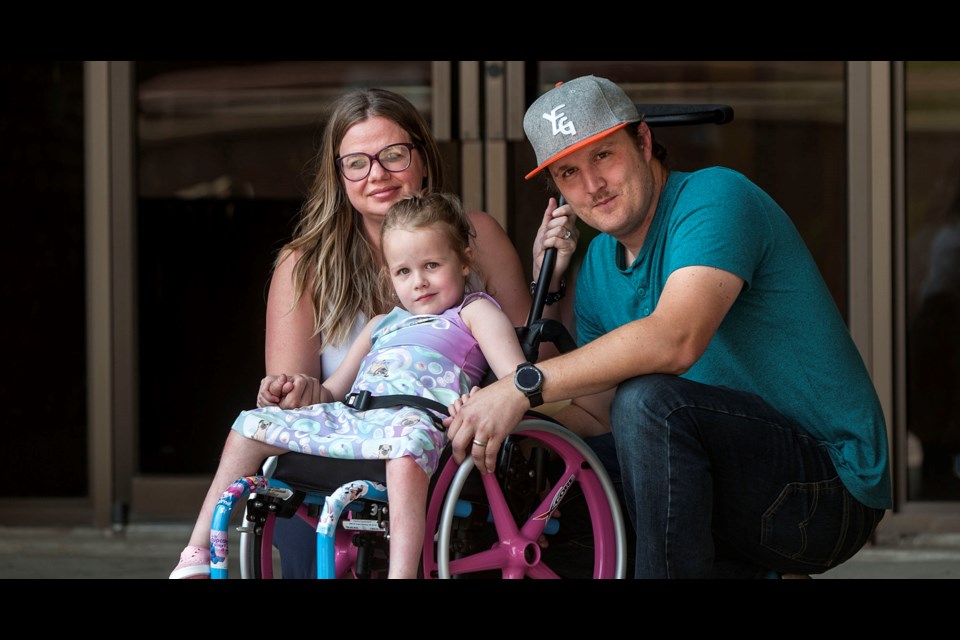In most ways, Emmy is just like the rest of her toddler peers: she can often be found impersonating her favourite Disney princess Elsa, singing “Let It Go”, she celebrates big occasions with Chicken McNuggets and loves to play with friends.
And soon Emmy plans to learn how to skateboard – but with the assistance of her tiny, bright pink wheelchair.
When Jodi Richardson was 22 weeks pregnant, doctors told her and her husband Lee their now bright-eyed, energetic toddler would be born paralyzed from the waist down.
“We just processed as best we could, then she came out and she wasn’t paralyzed ... she came out kicking like no problem,” Jodi said.
When her daughter was born with clubfoot, doctors thought the newborn had spina bifida, because the two often occur together. Ultimately, she was diagnosed with spinal dysgenesis, an umbrella term meaning the spine did not develop properly.
Emmy’s first year out of the womb was spent undergoing endless therapies and surgeries. From two and a half weeks to seven months, Emmy had painful weekly casting sessions to treat her clubfoot.
Since March of this year, Emmy has undergone three surgeries, including fixing dislocated hips and removing the L4 vertebrae entirely.
Jodi said her daughter is “very strong” and at the age of four has fought a fierce battle to gain skills most ablebodied children pick up effortlessly, including the ability to walk, run and play. Emmy began walking semi-independently when she was three, after receiving extensive physical therapy.
“She is very strong and has fought for a lot of things already at (age) four, just the ability to walk and run and play,” Jodi said.
Emmy will always require a mobility aid, Jodi said, which usually involves a walker but sometimes a wheelchair for longer distances.
Having a child with mobility challenges has completely reshaped the way Jodi and her husband see the world. Now, they see the world and make plans through the accessibility lens.
“We’re just constantly looking for the accessible route to things,” Jodi said, noting she and her husband have to prepare in advance for a lot of the things they do.
This involves calling ahead to events and facilities to ask if they are accessible, and what exactly that means.
Jodi said for the most part physical accessibility levels are pretty good in St. Albert, but the family definitely experiences challenges.
For example, making a stop at the toilet while visiting the public library in St. Albert Place is almost impossible with a wheelchair. The family also loves to pick up local goods at the farmers market, but after finding parking in one of the accessible stalls there is only one ramp between the parking lot and the market.
“Even though you have an accessible stall, it’s not accessible to actually get to where you’re going because you have to lift her over the curb,” Jodi said.
What really weighs heavy on her mind as a parent is accessible playgrounds, as Emmy approaches school-age.
“Not being able to go on the playground with her peers is definitely an isolating experience causing attention to her disability instead of her abilities.”
City works on accessility
Those who live with disabilities will ideally not have to face accessibility challenges like the ones Emmy deals with in public spaces, after the city completes an update to its engineering design standards.
Part of the city’s universal access plan – released last September – includes implementing engineering design standards borrowed from Burlington, Ont.
St. Albert planning branch manager Kristina Peter said the Burlington accessibility design standards were acquired in the spring, and the city is now working to incorporate the standards into its own.
“If we were to build a new building, or even retrofit this building, you would end up with quite a few more improvements for people with mobility challenges,” Peter said.
She added an example is the future Campbell Road Park and Ride, which will ensure bus stops and shelters are in keeping with the city’s universal access plan.
Updated design standards is just one of a series of recommendations in the 227-page universal access plan, which is meant to make the city’s sidewalks, crossings and trails, public facilities and transportation barrier-free to the most people possible.
The plan is broken up into three phases representing immediately attainable items, and others in the medium and long-term. There are no deadlines in the plan.
Another immediate priority is conducting audits on three major city facilities: St. Albert Place, Servus Place and Fountain Park.
Peter said the city is going through the process of procurement and has not put the audits to tender yet.
“It is a little bit slower. We thought we’d be a little further ahead but we’re just not,” she said.
St. Albert has earmarked $300,000 for the three audits and some minor upgrades in 2019-2020.
Coun. Natalie Joly said the plan is a good foundation for the city into the future.
“I think it does a good job of identifying our strengths and our weaknesses and where we need to go and it’s a good foundation for us to make better decisions going forward,” she said.
Joly added she would like to see faster movement on the plan but understands the need to make plans “thoughtfully” and in concert with the disability community.
“We’re not going to be implementing everything at once, and that’s going to be the real challenge, is making sure we’re balancing moving forward with the plan with the really practical needs of running a city, and the budgeting constraints involved in that,” she said.
For Jodi, accessibility means knowing her daughter will be able to do anything someone else without a physical limitation can.
“Accessibility to me is also welcoming and inclusion.”




